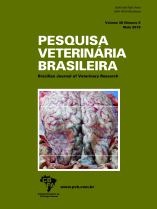 |
|
|
|
Year 2018 - Volume 38, Number 5
|

|
Claviceps purpurea e Bipolaris sp. as a cause of ergotism in cattle in Santa Catarina State, 38(5):875-882
|
ABSTRACT.- Hemckmeier D., Galindo C.M., Melchioretto E., Gava A. & Casa R.T. 2018. [Claviceps purpurea e Bipolaris sp. as a cause of ergotism in cattle in Santa Catarina State.] Claviceps purpurea e Bipolaris sp. como causa de ergotismo em bovinos no estado de Santa Catarina. Pesquisa Veterinária Brasileira 38(5):875-882. Laboratório de Patologia Animal, Centro de Ciências Agroveterinárias, Universidade do Estado de Santa Catarina, Avenida Luís de Camões 2090, Bairro Conta Dinheiro, Lages, SC 88520-000, Brazil. E-mail: a6.deise.hemckmeier@gmail.com
Claviceps purpurea is the fungus associated with ergotism. Ergotism is a disease caused by the ingestion of esclerodios called ergot, which contains alkaloids that act on dopaminergic and adrenergic receptors, causing seratoninergic effect on blood vessels, smooth muscles and central nervous and autonomic system. The present study describes epidemiological data, clinical signs and lesions of a bovine cattle disease characterized by hyperthermia, tachycardia, tachypnea and injuries in the coronary band of the hooves. Initially the cause was attributed to the fungus Claviceps purpurea. Between 2000 and 2014, 13 outbreaks were described, being three of distermic form, seven of gangrenous and three of the convulsive form. However, in five out of the seven of the gangrenous form outbreaks, it has been observed a high incidence of smut grass (Sporobolus indicus) inflorescences infected by a blackened fungus, classified as Bipolaris sp., in the places where the bovine grazed. The disease was reproduced experimentally by administration of inflorescences of smut grass contaminated by Bipolaris sp. Five bovine received daily doses of 0.1g/kg, 0.2g/kg, 0.2g/kg, 0.26g/kg and 0.34g/kg during 4, 7, 9, 30 and 30 days respectively. After three to seven days of eating contaminated inflorescences four cattle had diarrhea, tachycardia, tachypnea and intermittent hyperthermia. These clinical signs happened on the warmest days and during the warmest temperatures of the day. A bovine showed hyperemia in the coronary band of the hoof and loss of tail tip hair. According to data obtained during the experimental reproduction, smut grass contaminated by Bipolaris sp. can cause hyperthermia, tachycardia, tachypnea, injuries in the coronary band of the hoof and loss of the tail tip hair in bovine cattle. |
| |
|
|
| |
|
 |